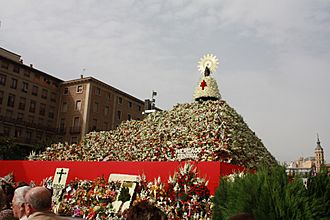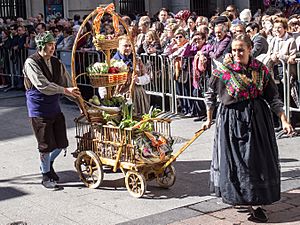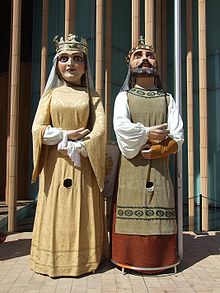Fiestas del Pilar facts for kids
Quick facts for kids Fiestas del Pilar |
|
|---|---|

Flower offering
|
|
| Observed by | Zaragoza, Spain |
| Type | Religious, Historical, Cultural |
| Significance | To honour Our Lady of the Pillar |
| Date | 12 October |
| Next time | 12 October 2026 |
| Frequency | Annual |
The Fiestas del Pilar is a big annual festival in Zaragoza, Aragon, Spain. It celebrates the city's patron saint, the Virgen del Pilar (Our Lady of the Pillar).
This exciting week-long festival usually starts on the weekend before or on October 12. It lasts until the next Sunday. The city organizes many fun events. Other groups and companies also hold their own shows, contests, and activities.
People in Zaragoza have honored the Virgin Mary since at least the 1100s. October 12 became a special day to remember a Marian apparition (a vision of Mary) in 1640. This date was later approved by the Church. October 12 is also a national holiday of Spain. It celebrates the discovery of the Americas.
Religious Celebrations
Solemn Mass of Infants
On October 12, the first Mass of the day is called the Solemn Mass of Infants. It takes place at 4:30 a.m. in the Saint Chapel of the Basilica del Pilar. Even though it's very early, many people attend this special Mass.
The Offering of Flowers
This is the most important part of the festival. It shows how much people love the Virgin Mary. All day on October 12, thousands of people wear traditional costumes. They bring flowers to a large statue of the Virgin in the Plaza del Pilar.
Volunteers carefully arrange the flowers around the statue. They create a huge flower "mantle" or cape. This beautiful display stays in the square for everyone to see during the festival. People can offer flowers alone or with a group. Many groups come from schools, companies, or nearby villages. They parade through the streets, ending at the main square.
The Flower Offering is very popular. Hundreds of groups take part each year. The parades can last for more than eight hours! In 2009, a record 450,000 people joined the flower parade.
This tradition started in 1952. Some city workers saw a similar festival outside Zaragoza. They decided to create one for their city, and it began in 1958.
A special Cross of Lorraine is often made with red flowers on a white background. This cross is a symbol of an old order of knights. It is offered by the General Royo Villanova Hospital. This tradition started in 1960 for patients who could not attend. The Festival Queen and her Court of Honour place the hospital's cross in a special ceremony.
Pontifical Mass
After the Offering of Flowers, a special Mass is held in the Basilica del Pilar at midnight. A parade follows this Mass.
The Offering of Fruits
On the morning of October 13, the Offering of Fruits takes place. This tradition is like a harvest festival. It first happened in 1949, even before the Flower Offering. People parade along a similar route. They bring the Virgin many different fruits. Most of these fruits come from the Aragon region of Spain.
The Glass Rosary Parade
The Glass Rosary parade, or Rosario de Cristal, is one of the most unique parades in the world. It started in 1889. It mixes religiosity (religious feeling) with art. The parade has 29 floats made entirely of glass. These floats are called "faroles" (lamps). They are lit from inside, creating a spectacular light show at night.
Fifteen floats show the mysteries of the rosary. Other floats show different things. Some are models of famous churches, like the Basilica del Pilar or the Sagrada Família. Others show religious and cultural themes.
Until 1926, people carried the glass floats on their shoulders. Candles lit them up. Electricity was first used to light them in 1940.
The Glass Rosary parade always begins at sunset on October 13. It starts from the Church of the Sacred Heart of Jesus. It then goes through the main streets and ends in the city center.
Other Celebrations
The Town Crier (Opening Speech)
The Town Crier, or Pregón, gives the opening speech for the festival. This happens on the Saturday before October 12. The speech is given from the balcony of the City Hall. Instead of a regular town crier, a well-known person from Aragon is chosen each year. It is a great honor to announce the start of the festival.
Giants and Big Heads Parade
The Giants and Big Heads are a favorite tradition in Zaragoza. "Cabezudos" are giant figures with huge heads made of papier-mâché. "Gigantes" are very tall giants. During the festival, these figures parade through the city streets every day.
There are ten "cabezudos," each with a different name and costume. They represent famous local characters. Children and teens often tease the cabezudos. In return, the cabezudos chase them and gently tap them with soft whips! The "gigantes" are more formal. They are regal, noble, and historic characters. They entertain people with their elegant dances in pairs. The current giants were designed in 1849.
General Fair of Zaragoza
The General Fair takes place at the Exhibition Hall of Zaragoza. It has many pavilions. These pavilions show different types of products, like food, furniture, cars, and science. There are also various shows and events to entertain visitors.
Activities for Children
Outdoor puppet shows and short theater plays are held in different parks. Some popular parks include Parque Delicias and Parque Jose Antonio Labordeta.
Funfair and Circus
The funfair comes to town during the festival. It has many exciting roller coasters and other rides. The funfair is held in the Fair Enclosure of Valdespartera. The circus also sets up its tents for shows.
Concerts
During the festival, many stages are set up all over the city. There are concerts for all kinds of music. Local and world-famous singers and groups perform. Concerts sponsored by the city are usually free. Others, sponsored by private groups, might have a fee.
Beer Fest
The Beer Fest, also known as "Oktoberfest," takes place in the Theme Park of Zaragoza. It is held under a large tent. You can find German products and lots of imported beer there. Waitresses wear traditional German costumes. A German orchestra plays music in the background. About three thousand people visit the Beer Fair every day.
Festival Finale
The festival ends with a grand finale. There is an outdoor concert in Paseo de la Independencia. A spectacular firework show lights up the sky over the banks of the river Ebro.
Images for kids
See also
 In Spanish: Fiestas del Pilar para niños
In Spanish: Fiestas del Pilar para niños








